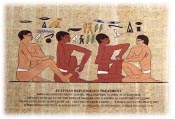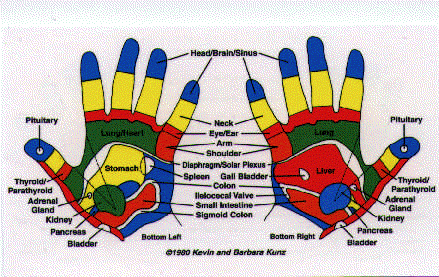The Healing Art of Reflexology

What is Reflexology?
The ancient healing art of reflexology has been known to man for
many thousands of years. It was first practiced by the early Indian,
Chinese and Egyptian peoples.
In 1913 Dr. William Fitzgerald, an American ear, nose and throat
surgeon, introduced this therapy to the West. He noted that pressure on
specific parts of the body could have an anaesthetizing effect on a
related area. Developing this theory, he divided the body into ten equal
and vertical zones, ending in the fingers and toes. He concluded that
pressure on one part of a zone could affect everything else within that
zone. Thus, reflex areas on the feet and hands are linked to other areas
and organs of the body within the same zone.
In the 1930's, Eunice Ingham, a therapist, further developed and
refined the zone therapy into what is now known as foot reflexology. She
observed that congestion or tension in any part of the foot mirrors
congestion or tension in a corresponding part of the body. Thus, when you
treat the big toes there is a related effect in the head, and treating the
whole foot can have a relaxing and healing effect on the whole body.
How Can Reflexology Help You?
The body has the ability to heal itself. Following illness, stress,
injury or disease, it is in a state of "imbalance", and vital energy
pathways are blocked, preventing the body from functioning effectively.
Reflexology can be used to restore and maintain the body's natural
equilibrium and encourage healing.
A reflexologist uses hands only to apply gentle pressure to the
feet. For each person the application and the effect of the therapy is
unique. Sensitive, trained hands can detect tiny deposits and imbalances
in the feet, and by working on these points the reflexologist can release
blockages and restore the free flow of energy to the whole body. Tensions
are eased, and circulation and elimination is improved. This gentle
therapy encourages the body to heal itself at its own pace, often
counteracting a lifetime of misuse.
Who Can Benefit From Reflexology?
Since reflexology treats the whole person, not the symptoms of
disease, most people benefit from treatment. The therapy brings relief to
a wide range of acute and chronic conditions, and is suitable for all
ages. Once your body is in-tune, it is wise to have regular treatments in
order to help maintain health and well-being. An increasing number of
people are using this safe, natural therapy as a way of relaxing,
balancing and harmonizing the body.
What Happens When You Go For Treatment?
On your first visit there is a preliminary talk with the
practitioner. The reflexologist then begins to work on your feet, or hands
if necessary, noting problem areas. There may be discomfort in some
places, but it is fleeting, and is an indication of congestion or
imbalance in a corresponding part of the body. For the most part, the
sensation is pleasant and soothing. Reflexology will relax you while
stimulating the body's own healing mechanisms.
Usually a treatment session lasts for about one hour. A course of
treatment varies in length depending on your body's needs. Your
reflexologist will discuss this with you at the first session. After the
first treatment or two your body may respond in a very definite way: you
may have a feeling of well-being and relaxation; or you may feel
lethargic, nauseous or tearful, but this is transitory. It is, however,
vital information for reflexologists, as it shows how your body is
responding to treatment.


|
![]()